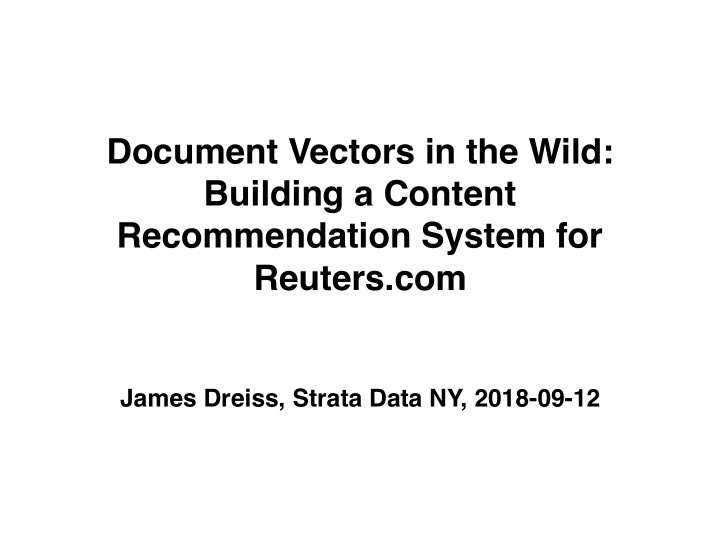



Document Vectors in the Wild: Building a Content Recommendation System for Reuters.com James Dreiss, Strata Data NY, 2018-09-12
reuters (lots of data)
why document vectors? content -> content recommendations - no user registration, perpetual cold start news evolves more quickly than labelled training sets flexibility for comparing variable length documents (more so than taking word vectors for first X # of words) 📉 ↑ ⬆ METRICS
NLP is hard 😤
“dog”
{ “dog” { “cat”
king - man + woman = queen also… programmer - man + woman = housewife (???) * * Bolukbasi, et al “Man is to Computer Programmer as Woman is to Homemaker? Debiasing Word Embeddings” (2016)
covfefe classifier average of related context embeddings despite the negative press
? + ? - ? = covfefe
classifier historic average of related context embeddings article ID trump kim launch
production! 🎭
doc2vec model was trained on 350k worth of reuters news articles avg length of article: 390 words; longest: 7,300 words 100 dim vectors, 20 epochs inference stochasticity
via nafalitharris.com
triplet accuracy
triplet accuracy results tech 79% business 71% science 75% national 69% personalFinance 75% sports 86% culture 86% health 85% world 69% AVG: 77%…comparable to triplet accuracy in Dai, et al. “Document Embedding with Paragraph Vectors” (79%) (for any requested article, only those within the same general topic articles are recommended, and all scroll articles have to have been at least somewhat popular within the last 24 hours)
web app (mostly) machine learning (elasticache and RDS)
testing ⚗
the test - tested serving similar scrolls, dissimilar scrolls, and top news scrolls (as a control), across every page of reuters.com (US, UK, and India editions) for a period of two weeks - each page randomly served one of these three test branches to each new viewer of that page, resulting in 4,839 article tests total
Lead Article: “Facebook-backed group to help fund 'Dreamer' application fees” Similar scroll (discrimination & legal issues in tech): - “Lawsuit accuses Google of bias against women in pay” - “Facebook suspends ability to target ads by excluding racial groups” - “Portland probe finds Uber used software to evade 16 government o ffi cials” - Dissimilar scroll (business & general tech): - “Beijing crypto-currency exchanges told to announce trading stop by - Friday: Securities Times” “FTC probes Equifax, top Democrat likens it to Enron” - “Samsung enters autonomous driving race with new business, funding” - Top news scroll - “United States says North Korea endangers whole world after missile test” - “U.S. nearing limits of diplomacy on North Korea: Trump adviser McMaster” - "Florida governor vows aggressive probe of Irma nursing home deaths” -
test results: overall performance - similar scrolls resulted in a higher average “scroll depth” — the average number of page loads in a scroll Avg Scroll # of Winning Source Depth Pages similar 2.33 1,908 dissimilar 2.29 1,298 top news 2.29 1,351 - di ff erences were consistent across all pages: similar scrolls were the “winners” against dissimilar and top news scrolls in 39% (1,908) of all article tests - top news scrolls won 28% (1,351) and dissimilar 27% (1,298); 6% were inconclusive
within topic di ff erences - trends held over all article topics, with greater di ff erences in more niche areas, such as sports - suggests that users who visit these more niche topics are inclined to read on and explore them in greater detail
⬆ article quartile depth - article quartile depth: how deep users are getting into the articles that make up a scroll - roughly 2.3% of users scrolled to the final quartile of the second article in similar scrolls, versus 1.9% and 2% for dissimilar and top news scrolls, respectively - indicates users are also more engaged with the content when it is similarly related
the future (reuters version) personalization - article length issues - the future (generally) embeddings 💁 ? - - “universal embeddings” for transfer learning - ELMo (“Embeddings from Language Models”) - captures polysemy - character level training to handle OOV words
END 👌
Recommend
More recommend